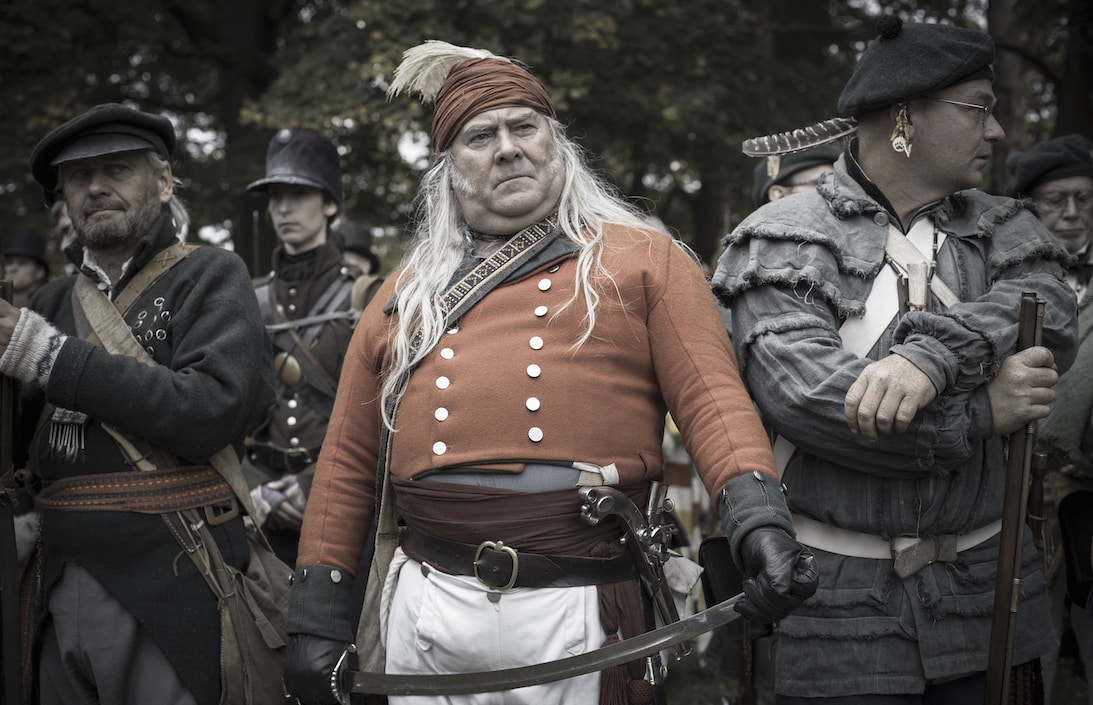
This costumed reenactor portrays the sort of British noncommissioned officer who often worked with irregular Canadian troops and their First Nation allies. Photo by Cosmo Condina
Americans believe they won the War of 1812, but some historians disagree. The British burned Washington DC, occupied large swaths of America’s mid-Atlantic coast and repulsed military efforts to annex parts of Canada. This summer historical reenactors in Ontario will recreate the Battle of Ft. George (July 15-16) and the Siege of Ft. Erie (Aug 12-13), two of the bloodiest battles in Canadian history. Be sure to view Cosmo Condina’s photo essay on the Niagara campaign. Then read his story below on what it’s like to participate in a historical reenactment.
David DeVoss, Editor, East-West News Service
By Cosmo Condina
Major battle campaigns in the War of 1812 are commemorated in the Niagara Region by re-enactors from Canada and the United States to recreate camp life and battle scenes. My first encounter with these weekend warriors was in Fort Erie, Ontario back in 2007. I thought I had come across a movie set, but I soon learned that people of all ages come together to reenact a pivotal moment in North American history.
Why was I thinking the idea of acting as an 1812 re-enactor would be a fun experience as I lay awake at 3:00 am in a cotton canvas tent with no flooring or sleeping bag. At least things can’t get any worse I dreamed when suddenly thunder booming off Lake Ontario announced the arrival of torrential rain, which began creeping slowly across the tent’s dirt floor.
I was trying to immerse myself into this historical era, to create the most intimate and authentic photographs as possible for a War of 1812 bicentennial book. Whenever I was on the field, I had strict instructions to keep my camera equipment concealed or I would be tapped on the shoulder by an officer and removed from the scene. It was important to respect the protocol, otherwise my images would lack the intimacy of being close to the action.
No Breaking Character for Historic Reenactors
I was adopted by the 104th New Brunswick Regiment. Re-enactors will research real people from that time and take on that persona. Groups will form regiments and this becomes their “tribe”.
The real 104th New Brunswick Regiment sent out six companies on snowshoes from Fredericton on February 16, 1813 overland to Quebec, and then on to Kingston. In spite of temperatures approaching -250F ( -310C), the detachments arrived in Quebec in mid-March, travelling 350 mi. (550km) in twenty-four days. In the spring of 1813, the remaining companies sailed to Niagara and joined in the war efforts.
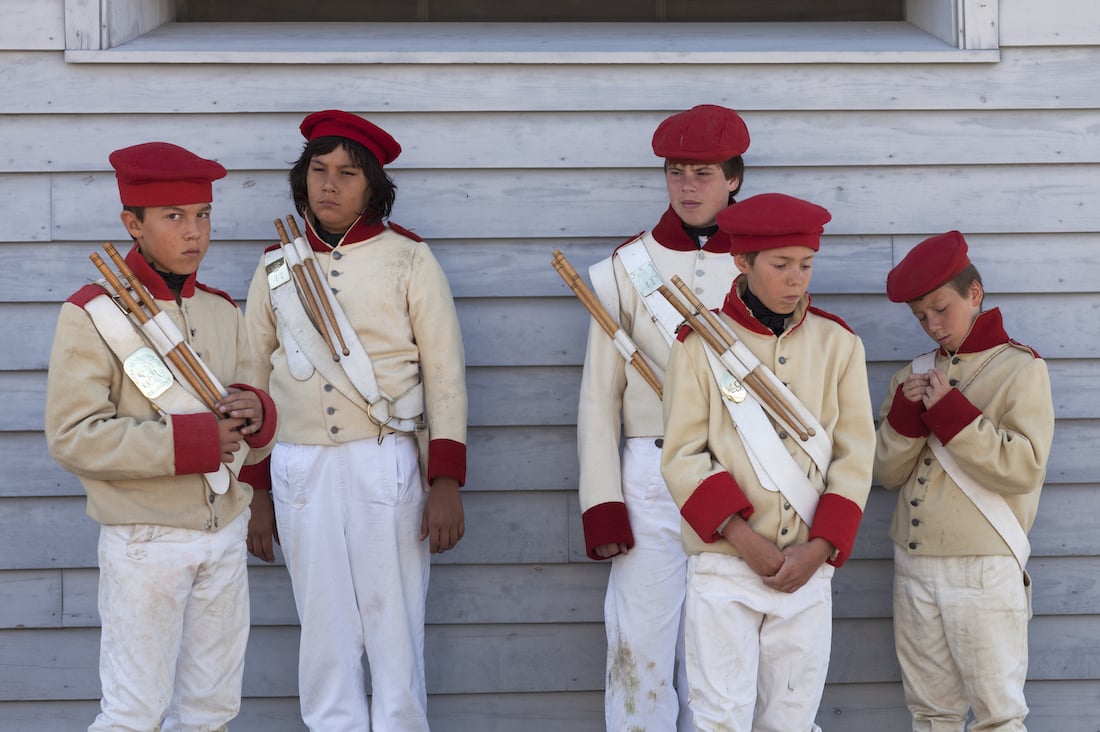
Participants of all ages are needed when staging a 19th century military conflict. These youths portray members of a Fife and Drum Corps. For young boys pressed into service there was no place to hide since they typically marched into battle ahead of the adults. Photo by Cosmo Condina.
One of the reasons that so many battles took place in the Niagara Region was the strategic value of the Niagara River which is the gateway to the Great Lakes. The country that controlled the water access to western North America, would have a commanding commercial advantage. The French built the first fortified structure, Fort Conti, at the mouth of the Niagara River and Lake Ontario in 1678 for the same reasons. It was replaced with a stone structure in 1726 that became Ft. Niagara.
The encampments are meant to transport you back to the 1812 era with genuine-looking clothing, cooking apparatus, sleeping quarters and all the hardware for a battle scene recreated in an authentic fashion. There is a whole industry providing services to create and sell all those items that were common in the day. The idea is that nothing of the modern age should be in view of the public. Some exceptions are modern eye glasses and shoes.
Two Centuries Later, You Still Can Dress for 1812 Combat
The typical British Regular of the War of 1812 might look as follows: Uniform Coatee, white linen shirt, black neck stock, straight bottom trousers, half gators, low quarter shoes, shako, cartridge box with white buff sling, white buff baldric for bayonet scabbard, haversack, knapsack, tin canteen. To further research the type of items available one supplier is C&D Jarnagin Company.
The British uniform, historically made of wool, was a scarlet red. In the days of the musket (a weapon of limited range and accuracy) and black powder, battlefield visibility was quickly obscured by clouds of smoke. Bright colors provided a means of distinguishing friend from foe without significantly adding risk. No historical basis can be found for the suggestion that the color red was favored because of the supposedly demoralizing effect of blood stains on a uniform of a lighter color.
US soldiers were issued a knapsack that included all their personal effects. These included items for shaving, a comb, a deck of playing cards (despite gambling being illegal in the barracks), a quill pen, and ink well.
Soldiers were issued a blanket, linen shirts, linen trousers, extra socks, fatigue blouse, and fatigue cap. They would also receive wool trousers and a dark blue superfine wool waistcoat, white breeches or trousers, black shoes and a black bicorne hat.
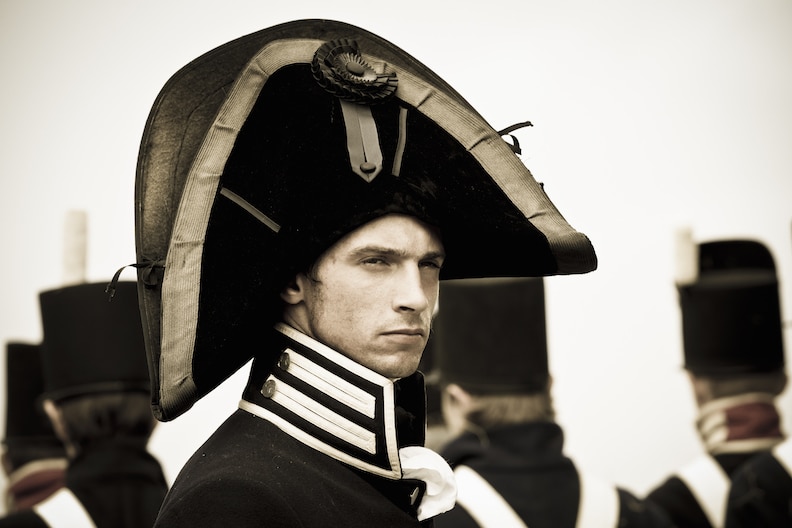
This reenactor, probably from New York, portrays an American officer wearing a bicorne hat. Photo by Cosmo Condina
Anyone who handles a firearm must be insured, licensed and take training even though no live ammunition is used. Gunpowder is handled to create the fire and spark of muskets and canon being fired. Flintlock firearms were widespread. The most commonly used were the Brown Bess Musket circa 1812-1815, the Springfield Model 1795 musket and Harper’s Ferry 1803 rifles. Replicas retail between $600-$750 US.
How are muskets loaded? Gun powder was poured from the powder horn into a measure that held a pre-determined amount of powder. The powder charge was then poured down the barrel of the gun. A patched lead ball was then placed on the muzzle of the gun and then shoved down the barrel until it rested on top of the powder charge.
The average soldier was expected to release three volleys per minute; four was exceptional. After the first volley, troops usually took from twenty to thirty seconds to reload. No lead ball is loaded in the musket of a re-enactor. Without the training the potential for harming one another is possible.
The members of a regiment are like a military hierarchy. You earned your way up the ranks to be an officer. Being an outsider, I had no experience or apparel to be on the field. I was given an officers uniform which fit me. I soon realized the power of the uniform. Around the encampment I was being saluted. It became apparent that there were re-enactors questioning the merit of my elevated position and I was soon relegated to a lowly civilian position.
First Nations re-enactors are present also. They played an important role in helping the British effort against the Americans. Without their support the British would have lost the war from the very beginning. Both the Americans and the British needed their support and every effort was made by each to keep the Western First Nations apart, or at least neutral, fearing a unified warrior army would have tipped the scales.
A First Nations face transformed by warrior paint can be a visually menacing threat on the field. Amusingly, I would later encounter one of these terrifyingly transformed persons at a swing dance class.
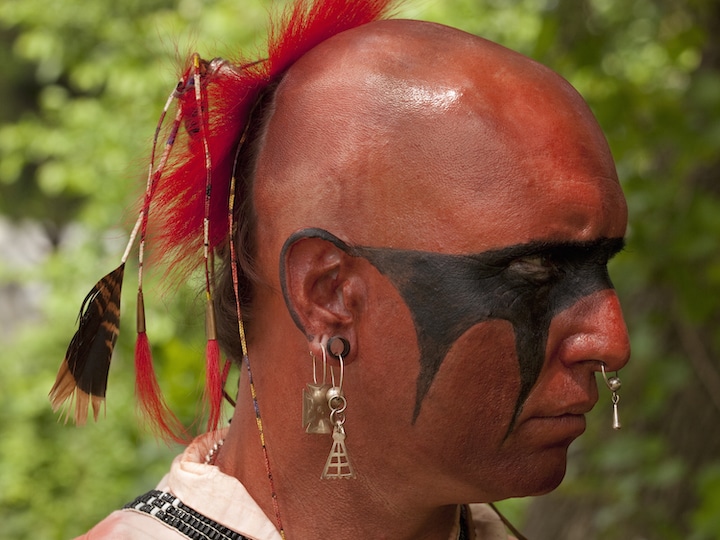
Indigenous Canadians played a central role in the Battle of Stoney Creek. The intimidating appearance of a First Nations native in battle dress was intended to shock American soldiers, who had the advantage in armament. Photo by Cosmo Condina
Re-enactors are a community. Groups travel great distances across the Canada-US border, but there has been a hiatus the past couple of years because of Covid-19.
The Siege of Fort Erie is the ”Largest Annual Re-enactment in Canada.” August 6-7, 2022 marks the 37th anniversary of the reenactment. Making historic sites come to life takes an incredible amount of time and money. Safety lines, emergency plans, pyrotechnics permits and staffing are all prepared in advance. The staged explosion of the powder magazine is the climax of the weekend event. The battle scene rages with troop advancements. The air is clouded with gun smoke. The moment the charge of the gunpowder mixed with peat moss explodes, a fireball creating an intense heat can be felt by all. For first-timers at the event it’s surprisingly exciting.
Massive Explosions with no Damage
Peter Martin, special events coordinator for Niagara National Historic Sites explains how the special effects take place. Ground-charges to blow up a building become complicated when no digging is allowed on archeological sites.
“But we’ve worked with experts to use big tubes of steel. You put the charge at the bottom, fill them with peat moss and then hide them. All you see is the explosion and the flying earth; you don’t think about where it came from.”
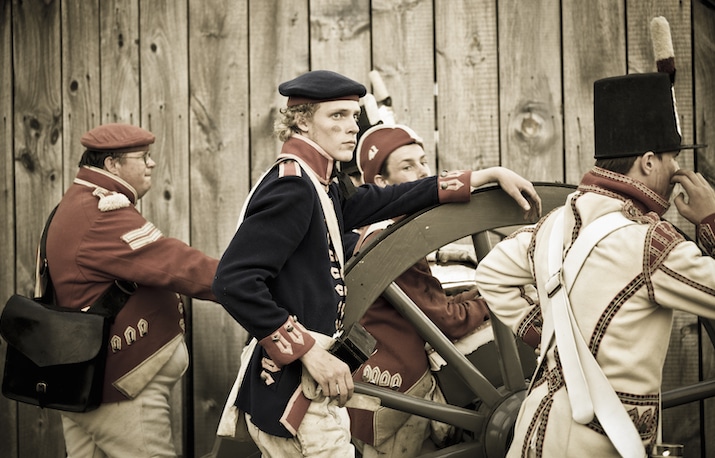
These artillerymen, costumed to represent Canada’s 41st Regiment, would have experienced action at Ft. George, scene of another conflict in the Niagara Campaign. Photo by Cosmo Condina
“At the same time, it has to be safe, both for the spectators and the re-enactors. You may have 300 of them on the field and it has to be very clear where they can and cannot go. There’s always a staff guy on hand to say, ‘The field is clear,’ before they cross.
“It’s not just keeping them away from the explosions; there are holes left behind and you don’t want them tripping and maybe getting injured.
“This is just a pretend battle. Guys fall over and play dead, but then they get up again. The idea is for it to end without a single casualty.”
Re-enactments of historical battles such as the Battle of Waterloo or Stalingrad are played out throughout Europe. In the U.S. the preference is to breathe life into Civil War battles. There are Viking battle re-enactments, Roman Empire, World War 1 and 2 and others. You will find English people in French uniforms, or Germans dressed as Nazis firing against their fellow countrymen. In the Battle of Teutoburg Forest, a German plays a Roman or an Italian a German.
What purpose is served by the recreation of these battles? Hopefully, the lesson to be learned is that seeking peace is a better alternative to military conflict.
Cosmo Condina lives in Niagara-on-the-Lake, Canada. Please see his featured photography essay on the War of 1812’s Niagara Campaign.

